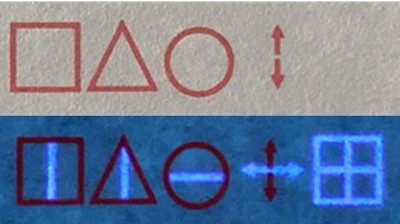FOR IMMEDIATE RELEASE
ACS News Service Weekly PressPac: May 05, 2021
An uncrackable combination of invisible ink and artificial intelligence
“Paper Information Recording and Security Protection Using Invisible Ink and Artificial Intelligence”
ACS Applied Materials & Interfaces
Coded messages in invisible ink sound like something only found in espionage books, but in real life, they can have important security purposes. Yet, they can be cracked if their encryption is predictable. Now, researchers reporting in ACS Applied Materials & Interfaces have printed complexly encoded data with normal ink and a carbon nanoparticle-based invisible ink, requiring both UV light and a computer that has been taught the code to reveal the correct messages.
Even as electronic records advance, paper is still a common way to preserve data. Invisible ink can hide classified economic, commercial or military information from prying eyes, but many popular inks contain toxic compounds or can be seen with predictable methods, such as light, heat or chemicals. Carbon nanoparticles, which have low toxicity, can be essentially invisible under ambient lighting but can create vibrant images when exposed to ultraviolet (UV) light – a modern take on invisible ink. In addition, advances in artificial intelligence (AI) models — made by networks of processing algorithms that learn how to handle complex information — can ensure that messages are only decipherable on properly trained computers. So, Weiwei Zhao, Kang Li, Jie Xu and colleagues wanted to train an AI model to identify and decrypt symbols printed in a fluorescent carbon nanoparticle ink, revealing hidden messages when exposed to UV light.
The researchers made carbon nanoparticles from citric acid and cysteine, which they diluted with water to create an invisible ink that appeared blue when exposed to UV light. The team loaded the solution into an ink cartridge and printed a series of simple symbols onto paper with an inkjet printer. Then, they taught an AI model, composed of multiple algorithms, to recognize symbols illuminated by UV light and decode them using a special codebook. Finally, they tested the AI model’s ability to decode messages printed using a combination of both regular red ink and the UV fluorescent ink. With 100% accuracy, the AI model read the regular ink symbols as “STOP”, but when a UV light was shown on the writing, the invisible ink illustrated the desired message “BEGIN”. Because these algorithms can notice minute modifications in symbols, this approach has the potential to encrypt messages securely using hundreds of different unpredictable symbols, the researchers say.
The authors acknowledge funding from the Shenzhen Peacock Team Plan and the Bureau of Industry and Information Technology of Shenzhen through the Graphene Manufacturing Innovation Center (201901161514).
###
The American Chemical Society (ACS) is a nonprofit organization chartered by the U.S. Congress. ACS’ mission is to advance the broader chemistry enterprise and its practitioners for the benefit of Earth and all its people. The Society is a global leader in promoting excellence in science education and providing access to chemistry-related information and research through its multiple research solutions, peer-reviewed journals, scientific conferences, eBooks and weekly news periodical Chemical & Engineering News. ACS journals are among the most cited, most trusted and most read within the scientific literature; however, ACS itself does not conduct chemical research. As a leader in scientific information solutions, its CAS division partners with global innovators to accelerate breakthroughs by curating, connecting and analyzing the world’s scientific knowledge. ACS’ main offices are in Washington, D.C., and Columbus, Ohio.
To automatically receive press releases from the American Chemical Society, contact newsroom@acs.org.
Note: ACS does not conduct research, but publishes and publicizes peer-reviewed scientific studies.
Media Contact
ACS Newsroom
newsroom@acs.org
View the image


